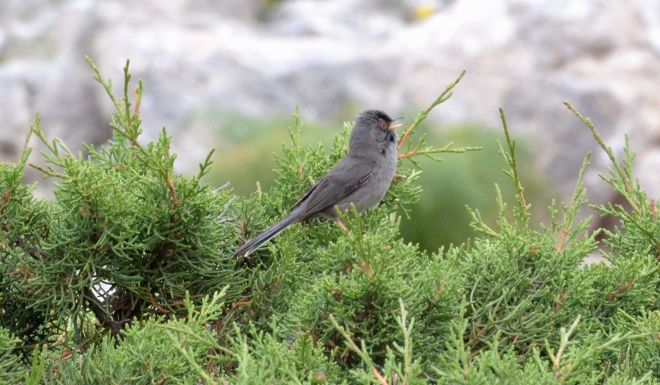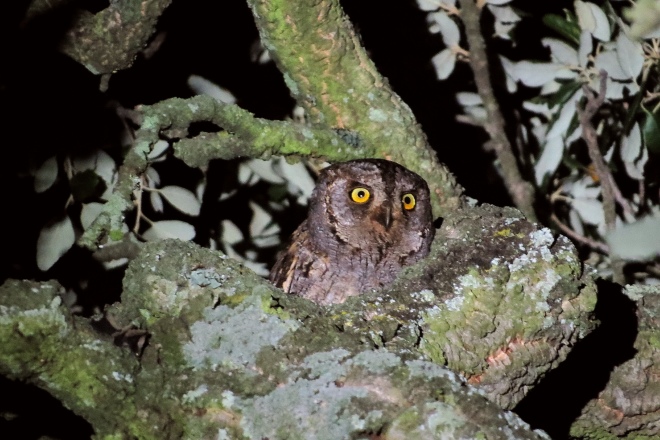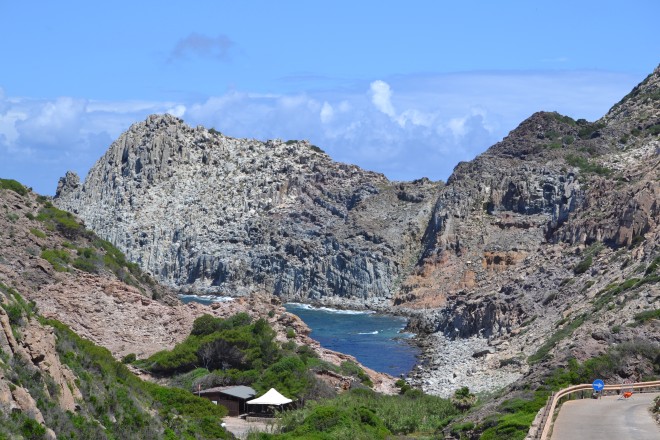I have just returned from a week’s tour of Sardinia with Naturetrek. The itinerary’s main focus was Odonata but I also had three must-see birds for the trip and all of them were found. A fourth life list addition was the endemic Tyrrhenian Flycatcher, that was split as a species from Spotted Flycatcher in 2015.
On 4th we visited Capo Caccia, near Alghero in the north-west of the island. There as the group enthused over what for me are now commonplace Mediterranean birds, I became distracted by lizards at the roadside. That was until I noticed everyone gathered about 100 metres away and clearly observing something of note. I hurried over to find that one of our guides, Luca Boscain had discovered a territorial Marmora’s Warbler which could not have read the script that they are by reputation skulkers offering only glimpses of themselves.

Marmora’s Warbler
This was my top target and now bird of the tour simply because they breed locally only in the Tyrrhenian islands (with a different race in the Balearics), wintering in North Africa. So I do not expect to see another one anytime soon. The species resembles Dartford Warbler in size and shape but has grey not red-brown underparts. They favour dry, scrubby locations, often in low maquis or rocky terrain.
One had been pointed out to me in Corsica last September flitting just once from cover to cover but to my mind it could have been anything, hence my desire to gain proper views this time. And the bird pictured below was quite exceptional in that respect, moving from one to another prominent perch on shrub tops or rocks, singing feistily all the while. To say this sighting exceeded my expectations is an understatement. What a beauty!
On 5th and 6th we stayed overnight at Su Baione near Abbasarra in central Sardinia, a remote location in a Cork Oak woodland. From dusk onwards the air around our hotel was filled continuously with the deep whistling calls of Scops Owl, but they were much harder to actually see. This is a small migrant Owl that is a widespread breeder across southern Europe, and also a long-time straggler on my remaining wish-list for the region.
During the first evening’s after dinner walk the group was more interested in locating Nightjar, that were heard distantly and so I was frustrated in my own aim. Returning to my room more Owls could be heard outside the window and so I sat out on the balcony for a while, still without success. Naively I expected to see them flying from tree to tree but they were rather more difficult to pick out than that, as the second evening’s experience demonstrated.

Eurasian Scops Owl courtesy of Luca Boscain
This time the group’s focus was the same as my own and the more experienced amongst us picked out a calling Scops with torches. It took a while to get my eye in then first the bird was seen from behind, dipping its tail with each call at 3-4 second intervals, and next head on from the other side of the tree (pictured above). At all times this Owl kept very close to branches at the centre of the tree, hence my own failed attempts at observation previously.
So that was two down and one to go: Eleonora’s, said to be the scarcest European Falcon. This summer visitor breeds colonially on islands throughout the Mediterranean, wintering in Africa. It owes it’s important lifer status to being absent from my Cyprus list, but I was probably there too early in the season in April 2012 since Eleonora’s postpones breeding until late summer to coincide with return passage of small passerines that are caught over the sea.

Eleonora’s Falcon nesting cliffs on San Pietro island
On 8th we visited San Pietro island off Sardinia’s south-west corner, a long established breeding location for Eleonora’s Falcon. On the walk down to the nesting cliffs (above) I concentrated on scanning the rock faces ahead, seeing a dark, Falcon-shaped silhouette emerge from one of the many crevices and holes. But not having seen an Eleonora’s before I didn’t like to call it. Eventually our guides spotted another one against the sky and so I knew that I had indeed self-found this newest lifer while the group were busying themselves with roadside bugs.
To quote Collins, this is a medium-sized Falcon with long, comparatively narrow wings, long tail and rather slim body. It was clearly still early in their season and there were not many birds present, but those of us who left last had another sighting on the walk back up. It was an immense relief for me to have gained all three required lifers for this trip, especially as we did not find some key dragonfly targets which was very disappointing.
Tyrrhenian Flycatcher (pictured above) was encountered fairly frequently during this tour. It struck me as quite an urban sort of bird, given to hanging around hotels and bars and getting into dubious company such as groups of ageing British wildlife enthusiasts. My own brief researches reveal that prior to 2015 seven sub-species of Spotted Flycatcher (Muscicapa striata) were recognised across the Palearctic region. Studies of the Sardinian and Corsican breeding population (M. striata tyrrhenicais) over 10 previous years confirmed morphological differences previously observed in the field and cited in scientific literature and hence the latter was split as a full species.
To put things very simply, the paper I am quoting (†) cites the immediate impression given by Tyrrhenian Flycatcher is of a paler bird with warmer tones to the back and more homogeneous underparts. The breast markings, which are generally well defined streaks in Spotted Flycatcher (M. striata striata), appear faded and more spot-like, and the streaking on the nape is also less well defined. My own experiences this week certainly confirm this, but as always I have quoted very basic detail herein.
† Biodiversity Journal, 2015, 6 (1): 271–284. Morphological differences between two subspecies of Spotted Flycatcher, by Michele Viganò and Andrea Corso.




